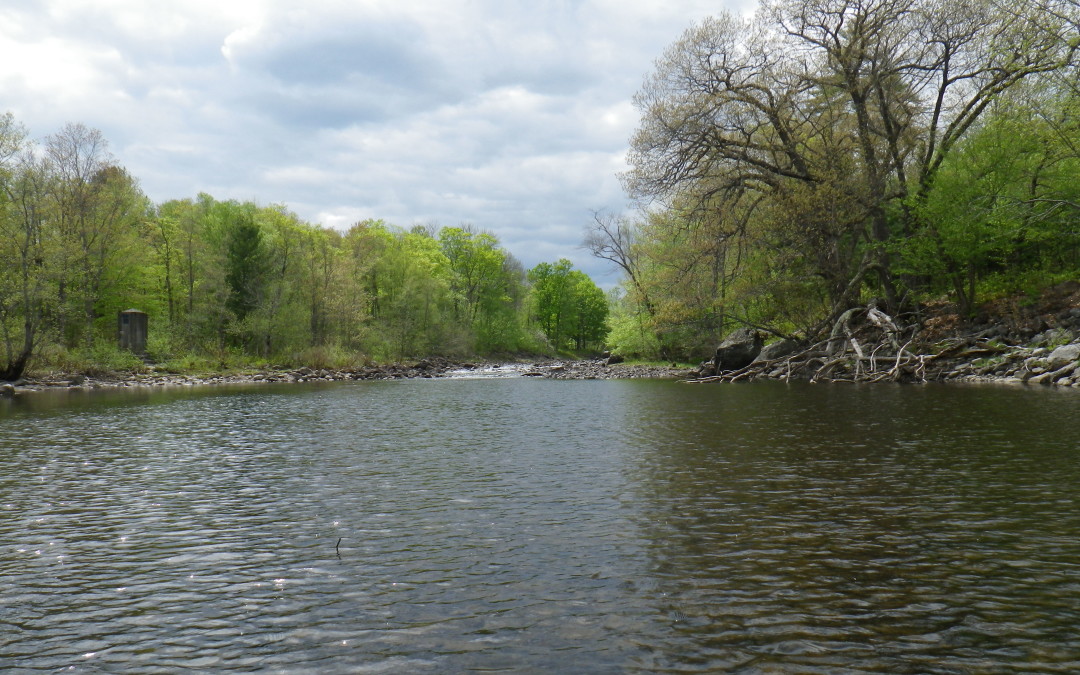It is always a pleasure for me to fish where it all began. The Sebec River is that place and I cut my teeth as a new fly fisher with my Dad’s old Cortland 8 weight rod with a broken tip. When I had the rod tip fixed it was six inches shorter and was better suited for bass or pike fishing rather than trout and salmon, but that is what I had at the time and I made the best of it. I struggled the first few years in putting it all together as I watched numerous individuals fish and I was always observing what they were doing. It wasn’t until I watched an old poacher at the Gauge Pool fish his lure along the heavy current seams that I put it all together. I have never looked back and I remember the hits on my streamer almost instantly when I imitated the same retrieve as the old poacher. Things sure have changed from those earlier years. The flows on the Sebec River are now much more unpredictable than before and the state has began stocking the river with brook trout on a yearly basis. I had only caught one trout on this river leading up to the introduction of this stocking program. The majority of the fish I caught were salmon. When I was fishing there in late May the water was extremely low. Salmon need highly oxygenated water and heavy currents. There have been more days with the water real low than I ever remember and I hope that this does not become the norm.
The fishing for the trout was very fast when I got to the river in the afternoon. There were mayflies coming off very sporadically and the rises from the trout were splashy. At the tail of the Gauge Pool there was a pod of trout that I observed turning sideways under the surface near the bottom, which indicated the taking of nymphs. I put on a Hendrickson dry fly and managed a few trout, but when I switched to a Hendrickson nymph and fished it just under the surface I had a trout on every cast. All you need to do is have your floating line on and a fine tippet, at most 4 pound test, and roll your nymph between your fingers under the water to allow the imitation to sink slightly. If you do not do this step the nymph may float on the surface and may not act natural. If the nymph has weight built into it, either on the body or bead head you will not have to do this step. Cast in front of the pod of fish at least 4 to 5 feet to allow for the offering to sink slightly and retrieve your fly in short increments to give the imitation a lifelike movement.
There are also some very nice bass throughout this river. It is always a nice surprise to tangle with these strong fish. The traditional spots on the river where I would pick up bass consistently has changed due to increased sedimentation and erosion from the spring run off. However, these fish are very resilient and can be found in every pool alongside the trout and salmon. I use a black woolly bugger fished dead drift through the runs and at the end of the drift I allow the fly to swing up to the surface and retrieve it back to me. Many times a fish will follow the fly through the drift and will strike very aggressively on the swing. I have caught both salmon and bass in the same pool using this technique. Earlier that morning I had began my day on the West Branch of the Penobscot below the North Twin dam. This section of the river has a very strong current and needs to be approached with caution. Trolling in boats or canoes is a very effective technique here, but make sure that you have a back up anchor as it is common to hang up on the bottom and be unable to get your anchor back. I should know as I had to cut my anchor line once after an hour of trying to dislodge my anchor from the bottom. The log drives of the past have left many logs on the bottom of this deep river. The relics of this past time can be seen on the side of the river and along the shoreline. There are old rail lines in the woods leading to a massive concrete structure that was constructed to roll logs from rail cars into the river.
As for the fishing on this stretch one would not believe that the salmon would hold in the strong current let alone rise to floating insects unless you see it for yourself. These salmon have adapted to this current and my favorite memory was watching a floating beetle work its way across the current and a salmon took it in the middle of the river. That salmon came from ten feet from the bottom and casually took the beetle from the surface and retreated back to the bottom. It is always important in fishing to have a good pair of polarized sunglasses so that you could see events like this. Fishing in this stretch holds up throughout the summer and this section has an extended season with catch and release regulations after September 30th. The upper section has some good wading opportunities and if you can roll cast effectively you can cover both sides of the river all the way down to the bridge across Route 11. This section is general law so if you did not want to fly-fish you can use lures and bait. All methods are effective on this section of the river.
One very important note if you travel Route 11 is to watch out for moose along the road between Millinocket to Brownville, especially the area around the Jo-Mary Multi-use forest entrance. This area is a hot spot for moose so always be on the look out and keep your speed down. On the drive to the Sebec River I saw four moose and there were probably more that I did not see just inside the tree line. The other note here is that this is an active logging area so be cognizant of log trucks moving swiftly along the road. It is sometimes easier to pull over and just let them pass by. For me this area brings back very fond memories of vacationing on Jo-Mary Lake and fishing throughout that area as a child. I will always have a special place in my heart for this area regardless of where I am.









Are you still guiding? Interested in doing some salmon fishing in the rivers.
Jamie,
Currently I am doing most of my guiding for salmon in Grand Lake Stream in the spring and the month of October at Weatherbys Lodge. I do have some availability for the Roach River trips between September 10-17 and the upper West Branch trip September 22-October 1st. Send me an email at guides@petersonguideme.com for more info and to discuss details.
Jon